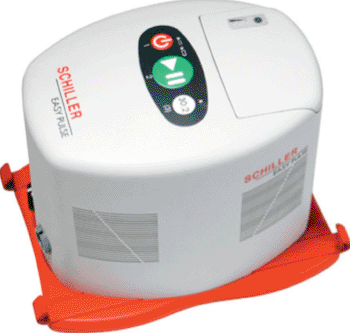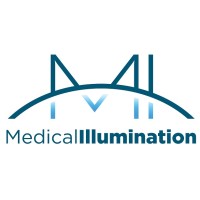Chest Compression Device Delivers Effective Resuscitation
|
By HospiMedica International staff writers Posted on 26 Dec 2013 |

Image: The Schiller Easy Pulse CPR compression device (Photo courtesy of Schiller).
A portable, standalone, mechanical device delivers chest compressions automatically at a consistent rate and depth.
The Schiller Easy Pulse offers efficient and compact electrically driven mechanical cardiopulmonary resuscitation (CPR) via multidirectional chest compressions at a consistent high-quality, with the possibility of performing 30:2 compression—ventilation cycles. The lightweight (3.5.kg) device is directly attached to the patient‘s upper body using a simple slider and buckle system, and can thus be used in any situation, regardless of ambient conditions.
Device operation is simple and straightforward, and can be performed by just a single person, whether a paramedic or even a lay rescuer. Only three buttons operate the device (Power, Start/Pause, and 30:2 compression), and resuscitation is initiated immediately once the Start button is pressed twice. The Schiller Easy Pulse is a product of Schiller (Baar, Switzerland).
A universal compression to ventilation ratio of 30:2 is recommended in most situations. With children, if at least two trained rescuers are present a ratio of 15:2 is preferred; in newborns a rate of 3:1 is recommended unless a cardiac cause is known, in which case a 15:2 ratio is reasonable. Compression-only CPR is recommended as the method of choice for the untrained or unproficient because it is easier to perform and instructions are easier to give over the phone. In adults with out-of-hospital cardiac arrest, compression-only CPR by the lay public has a higher success rate than standard CPR.
As per the American Heart Association (AHA; Dallas, TX, USA), the beat of the Bee Gees song "Stayin' Alive" provides an ideal rhythm in terms of beats per minute to use for hands-only CPR. One can also hum Queen's "Another One Bites The Dust,” which is exactly 100 beats-per-minute and contains a memorable repeating drum pattern.
Related Links:
Schiller
The Schiller Easy Pulse offers efficient and compact electrically driven mechanical cardiopulmonary resuscitation (CPR) via multidirectional chest compressions at a consistent high-quality, with the possibility of performing 30:2 compression—ventilation cycles. The lightweight (3.5.kg) device is directly attached to the patient‘s upper body using a simple slider and buckle system, and can thus be used in any situation, regardless of ambient conditions.
Device operation is simple and straightforward, and can be performed by just a single person, whether a paramedic or even a lay rescuer. Only three buttons operate the device (Power, Start/Pause, and 30:2 compression), and resuscitation is initiated immediately once the Start button is pressed twice. The Schiller Easy Pulse is a product of Schiller (Baar, Switzerland).
A universal compression to ventilation ratio of 30:2 is recommended in most situations. With children, if at least two trained rescuers are present a ratio of 15:2 is preferred; in newborns a rate of 3:1 is recommended unless a cardiac cause is known, in which case a 15:2 ratio is reasonable. Compression-only CPR is recommended as the method of choice for the untrained or unproficient because it is easier to perform and instructions are easier to give over the phone. In adults with out-of-hospital cardiac arrest, compression-only CPR by the lay public has a higher success rate than standard CPR.
As per the American Heart Association (AHA; Dallas, TX, USA), the beat of the Bee Gees song "Stayin' Alive" provides an ideal rhythm in terms of beats per minute to use for hands-only CPR. One can also hum Queen's "Another One Bites The Dust,” which is exactly 100 beats-per-minute and contains a memorable repeating drum pattern.
Related Links:
Schiller
Latest Critical Care News
- Ingestible Capsule Monitors Intestinal Inflammation
- Wireless Implantable Sensor Enables Continuous Endoleak Monitoring
- Pulse Oximeter Index Offers Non-Invasive Guides for Fluid Therapy
- Wearable Patch for Early Skin Cancer Detection to Reduce Unnecessary Biopsies
- 'Universal' Kidney to Match Any Blood Type
- Light-Based Technology to Measure Brain Blood Flow Could Diagnose Stroke and TBI
- AI Heart Attack Risk Assessment Tool Outperforms Existing Methods
- Smartphone Imaging System Enables Early Oral Cancer Detection
- Swallowable Pill-Sized Bioprinter Treats GI Tract Injuries

- Personalized Brain “Pacemakers” Could Help Patients with Hard-To-Treat Epilepsy
- Microscopic DNA Flower Robots to Enable Precision Medicine Delivery
- Origami Robots to Deliver Medicine Less Invasively and More Effectively
- Improved Cough-Detection Technology Aids Health Monitoring
- AI Identifies Children in ER Likely to Develop Sepsis Within 48 Hours
- New Radiofrequency Therapy Slows Glioblastoma Growth
- Battery-Free Wireless Multi-Sensing Platform Revolutionizes Pressure Injury Detection
Channels
Surgical Techniques
view channel
Robotic Assistant Delivers Ultra-Precision Injections with Rapid Setup Times
Age-related macular degeneration (AMD) is a leading cause of blindness worldwide, affecting nearly 200 million people, a figure expected to rise to 280 million by 2040. Current treatment involves doctors... Read more
Minimally Invasive Endoscopic Surgery Improves Severe Stroke Outcomes
Intracerebral hemorrhage, a type of stroke caused by bleeding deep within the brain, remains one of the most challenging neurological emergencies to treat. Accounting for about 15% of all strokes, it carries... Read morePatient Care
view channel
Revolutionary Automatic IV-Line Flushing Device to Enhance Infusion Care
More than 80% of in-hospital patients receive intravenous (IV) therapy. Every dose of IV medicine delivered in a small volume (<250 mL) infusion bag should be followed by subsequent flushing to ensure... Read more
VR Training Tool Combats Contamination of Portable Medical Equipment
Healthcare-associated infections (HAIs) impact one in every 31 patients, cause nearly 100,000 deaths each year, and cost USD 28.4 billion in direct medical expenses. Notably, up to 75% of these infections... Read more
Portable Biosensor Platform to Reduce Hospital-Acquired Infections
Approximately 4 million patients in the European Union acquire healthcare-associated infections (HAIs) or nosocomial infections each year, with around 37,000 deaths directly resulting from these infections,... Read moreFirst-Of-Its-Kind Portable Germicidal Light Technology Disinfects High-Touch Clinical Surfaces in Seconds
Reducing healthcare-acquired infections (HAIs) remains a pressing issue within global healthcare systems. In the United States alone, 1.7 million patients contract HAIs annually, leading to approximately... Read moreHealth IT
view channel
Printable Molecule-Selective Nanoparticles Enable Mass Production of Wearable Biosensors
The future of medicine is likely to focus on the personalization of healthcare—understanding exactly what an individual requires and delivering the appropriate combination of nutrients, metabolites, and... Read moreBusiness
view channel
Philips and Masimo Partner to Advance Patient Monitoring Measurement Technologies
Royal Philips (Amsterdam, Netherlands) and Masimo (Irvine, California, USA) have renewed their multi-year strategic collaboration, combining Philips’ expertise in patient monitoring with Masimo’s noninvasive... Read more
B. Braun Acquires Digital Microsurgery Company True Digital Surgery
The high-end microsurgery market in neurosurgery, spine, and ENT is undergoing a significant transformation. Traditional analog microscopes are giving way to digital exoscopes, which provide improved visualization,... Read more
CMEF 2025 to Promote Holistic and High-Quality Development of Medical and Health Industry
The 92nd China International Medical Equipment Fair (CMEF 2025) Autumn Exhibition is scheduled to be held from September 26 to 29 at the China Import and Export Fair Complex (Canton Fair Complex) in Guangzhou.... Read more














